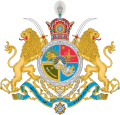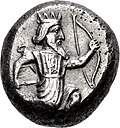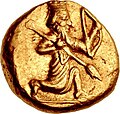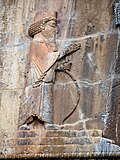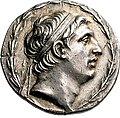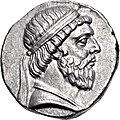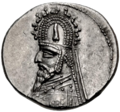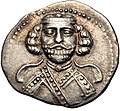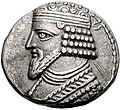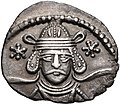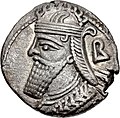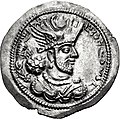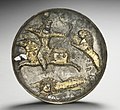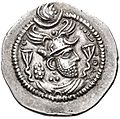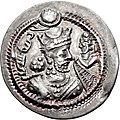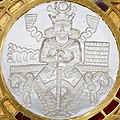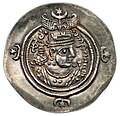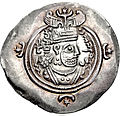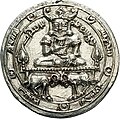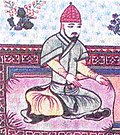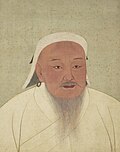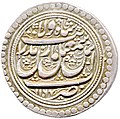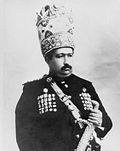Top Qs
Timeline
Chat
Perspective
List of monarchs of Iran
Rulers of Iran (678 BC–1979 AD) From Wikipedia, the free encyclopedia
Remove ads
The monarchs of Iran[c] ruled for over two and a half millennia, beginning as early as the 7th century BC and enduring until the 20th century AD. The earliest Iranian king is generally considered to have been either Deioces of the Median dynasty (c. 727–550 BC) or Cyrus the Great of the Achaemenid dynasty (550–330 BC). The last Iranian king was Mohammad Reza Pahlavi of the Pahlavi dynasty (1925–1979), which was overthrown by the Islamic Revolution. Since then, Iran has been governed as an Islamic republic.

In classical antiquity, Iran reached the peak of its power and prestige under the Achaemenid Empire, which stretched from Egypt and parts of Southeast Europe in the west to the Indus Valley and parts of Central Asia in the east. By 323 BC, the Achaemenid Empire's territories had been conquered by the Macedonian Empire during the Wars of Alexander the Great, bringing Iran into the Hellenistic sphere with the Seleucid Empire (305–129 BC). However, native Iranian rule was revived with the establishment and expansion of the Parthian Empire (247 BC–224 AD) and then the Sasanian Empire (224–651), which existed until the Arab conquest of Iran.
Medieval Iran alternated between being ruled by large foreign empires and being divided into several smaller kingdoms. Most of the Sasanian lands were annexed by the Rashidun Caliphate (638–661), which was succeeded by the Umayyad Caliphate (661–750) and then by the Abbasid Caliphate (749–861). Under the Abbasids, many Iranian figures took part in shaping the Islamic Golden Age, while also leveraging the decline of Arab power to establish independent dynasties and kingdoms, thus allowing their native languages to flourish and reviving Sasanian royal iconography and ideology in what became known as the Iranian Intermezzo. In the 11th century, Iran was conquered by the Seljuk Empire (1038–1194), which was Turkic in origin, but culturally Persianate. Further conquests by entities coming from Central Asia occurred over the course of the next five centuries, most notably including the Turkic Khwarazmian Empire (1097–1220/1221), the Mongol Empire (1220–1259), the post-Mongol Ilkhanate (1256–1335), and the Turco-Mongol Timurid Empire (1370–1458).
The year 1501 is considered the beginning of modern Iranian history, as the Kurdish-origin Safavid dynasty (1501–1736) rose to power and oversaw the conversion of Iran to Shia Islam, marking the region's largest religious shift since the Arab conquests. The collapse of the Safavids led to an intermediate period of turmoil, with rule of Iran contested between Safavid dynasts as well as the Afghan-origin Hotak dynasty (1722–1729). Nader Shah replaced these with the Afsharid Empire (1736–1796), but after his assassination in 1747, the Afsharids competed with the Zand dynasty (1751–1794) under Karim Khan Zand and his successors for supremacy. Iran was eventually reunified by the Qajar dynasty (1789–1925), which was succeeded by the Pahlavi dynasty of Reza Khan. The Pahlavi dynasty was the last to reign before the Iranian monarchy was abolished in 1979; Iran's head of state has since been the theocratic supreme leaders.
Remove ads
Ancient Iran (c. 727 BC–AD 651)
Summarize
Perspective
Medes (c. 727–550 BC)

The Median dynasty is traditionally considered to have ruled the earliest Iranian state.[4][5][6] Whether the Medes ruled an imperial state or merely a loose tribal confederation is disputed among historians.[7] Median history is reconstructed almost solely through ancient Greek sources (particularly Herodotus) and disregards Near Eastern sources, which are fragmentary and do not support the existence of a unified Median Empire.[8] There is also no material or textual evidence left behind by the supposed empire itself.[9][d] The chronology and names of the Median kings mainly derives from the work of Herodotus.[10][e]
No ruling title is securely attested for the Median rulers. They might have used šāhān šāh "King of Kings", the Middle Persian reflex of the Achaemenid title xšāyaθiya xšāyaθiyānām.[11] Ecbatana was the Median capital.[12]
Achaemenid Empire (550–330 BC)

The Achaemenid dynasty originated as local rulers of Anshan under Median suzerainty. They are attributed various ancestors in later legends, including an eponymous figure called "Achaemenes". The earliest securely historical Achaemenid ruler is Cyrus I, king of Anshan in the second half of the seventh century BC.[20] The Achaemenids united all Persian tribes under Cyrus I's son Cambyses I. Under Cambyses I's son, Cyrus II, the Achaemenids defeated the Medes and established the Achaemenid Empire,[20] the largest ever Iranian state.[7]
The standard title used by Achaemenid rulers in Iran from Cyrus II onwards was xšāyaθiya xšāyaθiyānām, xšāyaθiya dahyūnām (lit. 'King of Kings, King of the Lands').[21] The royal title varied in other parts of the empire.[f] The Achaemenids had several royal cities, including Pasargadae, Susa, Ecbatana, Babylon, Bactra, and Persepolis.[23]
Hellenistic rule (331–129 BC)
Alexander's empire (331–305 BC)

The Achaemenid Empire was defeated and conquered by Alexander the Great, king of Macedonia, in 331[43]–329 BC.[42] After Alexander's death in 323 BC, the Wars of the Diadochi broke out between his successors, leading to the rapid disintegration of the empire.[7]
Alexander did not assume the former Achaemenid royal title of 'King of Kings'.[44][45] His main royal title, appearing on coins intended for his Asian territories, was instead basileus (lit. 'king').[44] To mark his rule over the Achaemenid territories he also sometimes used the new title "Lord of Asia" (sometimes "King of Asia").[44] The only royal title recorded for Alexander's two immediate heirs is basileus.[46] Alexander ruled his empire from Babylon[47] and planned to establish Babylon and Alexandria in Egypt as the twin imperial capitals.[43] From 319 BC onwards, Alexander's heirs resided in Macedonia while the regency in Asia was contested by several generals.[48]
Seleucid Empire (305–129 BC)

The main Hellenistic successors of Alexander's empire in Iran were the Seleucids, descendants of the Macedonian general Seleucus I Nicator and the Iranian noblewoman Apama.[52] Seleucus seized most of the east, including Babylonia, in the Wars of the Diadochi and was firmly in control in the region from 312 BC onwards.[53] After Alexander IV's death became public knowledge in 305 BC, Seleucus proclaimed himself king.[54]
The main royal title used by the Seleucids was basileus, as was the case for the other Macedonian successor kingdoms (such as the Ptolemaic Kingdom).[55] Only two Seleucid rulers (Antiochus III, 223–187 BC, and Antiochus VII, 139–129 BC) used the greater megas basileus ('Great King'),[56] the style applied to Achaemenid kings in ancient Greek sources.[21] The Seleucids at first ruled from Seleucia in Mesopotamia, though Antioch was soon made the main capital.[57]
Parthian Empire (c. 250/247 BC–224 AD)

The Arsacids of Parthia,[54] initially Seleucid vassals,[59] originated as leaders of the Iranian[l] Parni tribe in the northeastern steppes.[62] The Parthians gradually challenged Seleucid rule over Iran.[63] Parthian control of Iran was secured through the c. 142 BC conquest of Babylonia.[54][63] Although fighting continued for years, the death of Antiochus VII Sidetes in 129 BC effectively marked the collapse of the Seleucid Empire,[63] which then lingered on as a rump state in Syria until conquered by the Roman Empire in the 60s BC.[54]
The Parthians presented themselves as heirs of the Achaemenids, though ruled a much more decentralized state.[62] Greek inscriptions were used on Parthian coins until the time of Vologases I (AD 51–78).[64] Early Parthian rulers used the name of their dynastic founder (Arsaces) as a title. Their coins also have the legend krny (probably short for autokrator, i.e. autocrat or sole ruler).[64] From the conquest of Babylonia onwards, rulers used basileus megas (lit. 'Great King').[63] Mithridates II (123–91 BC) adopted the Achaemenid 'King of Kings' (rendered in Greek as basileus basileon). After him, this title was used only by Mithridates IV (57–54 BC) and Orodes II (57–37 BC) before becoming a standard part of the Parthian title from the time of Phraates IV (26–2 BC) onwards.[65] The title was used in its Persian form (šāhān šāh) after Greek ceased being used.[66] The first Parthian capital was at Nisa in Parthia. In 217 BC, the capital was moved to Qumis and in 50 BC a multi-capital system was established, with royal residences at Ctesiphon, Ecbatana, and Ray.[67]
This list omits rival kings and claimants. Because of poor source material there are alternate chronologies, genealogies, and enumerations of Parthian rulers, with some differences. See the list of monarchs of Parthia.
Sasanian Empire (224 AD–651 AD)

The Sasanian dynasty originated as kings of Persis, a Parthian vassal kingdom, and claimed Achaemenid descent. In 224–226, the Sasanian dynast Ardashir I led a revolt against the Parthians, weakened in a recent civil war, and took control of the empire. Ardashir presented himself as a restorer of both regional unity and Achaemenid glory.[86] The Sasanian Empire was a significantly more militarily powerful, centralized, and aggressive state than the Parthian Empire and was also marked by a state-backed and less heterodox form of the Zoroastrian religion.[87]
Sasanian kings continued to use the title šāhān šāh (lit. 'King of Kings').[88][full citation needed] The title was extended by Ardashir to šāhān šāh ērān (lit. 'King of Kings of Iran')[89] and extended again by his son Shapur I (240–270) to šāhān šāh ērān ud anērān (lit. 'King of Kings of Iran and non-Iran').[89][90] Sasanian queens ruled with the title bānbišnān bānbišn ērān ud anērān (lit. 'Queen of Queens of Iran and non-Iran').[91] Ctesiphon was the capital of the Sasanian Empire.[92]
Minor kingdoms and dynasties
- The Fratarakas (3rd–mid-2nd century BC), rulers/governors in Persis under the Seleucid Empire
- Rulers of Parthian sub-kingdoms (2nd century BC–5th century AD), various local vassal dynasties of the Parthian Empire
- The kings of Persis (2nd century BC–3rd century AD), vassal kings in Persis under the Parthian Empire
Remove ads
Medieval Iran (651–1501)
Summarize
Perspective
The fall of the Sasanian Empire in 651 was followed by nearly a millennium without Iranian political unity, until the rise of the Safavid Empire in 1501.[113][114] In the intervening period, the territories formerly part of the ancient Iranian empires were variously subjected to larger foreign empires or divided into several smaller political units.[113] Although no unified Iranian state existed, shared Iranian identity, culture, and language continued to survive and develop throughout the Middle Ages.[113][114]
The medieval dynasties and kingdoms featured in this list follow a 2012 list of Iranian ruling dynasties by the Iranologist Touraj Daryaee.[115]
Arab (caliphal) rule (638–861)
Rashidun Caliphate (638–661)

The Muslim conquest of Persia began when the armies of the Rashidun Caliphate attacked parts of Sasanian Asoristan in 633.[116] In 637/638, the Sasanians lost Mesopotamia[100] The empire itself was conquered in 640–650.[100][117] By the time of Yazdegerd III's death in 651, the Sasanians only retained Bactria.[100] Following the Muslim victory, the Sasanian Empire was dissolved and Iran came under the direct rule of the Rashid caliphs.[118] Although the caliphs implemented forms of ethnic stratification that discriminated against Iranians and their culture, particularly during the later Umayyad Caliphate (661–750), they also adopted much of the old Sasanian administrative model to govern their empire.[119]
The style of the caliphs was amīr al-mu'minīn (lit. 'commander of the faithful').[120] An additional title, khalīfat Allāh (lit. 'deputy of God'), was also introduced beginning with Uthman (644–656).[121] The caliphate was initially ruled from Medina. Under Ali, the capital was transferred to Kufa in Iraq.[122]
Umayyad Caliphate (661–750)

The Umayyad Caliphate was established by Mu'awiya I, governor of Syria under the Rashidun caliphs. Mu'awiya opposed the acclamations of Ali and Hasan as caliphs,[122] leading to the civil war known as the First Fitna (656–661).[124] Mu'awiya was victorious and became undisputed caliph after Hasan relinquished his claims.[122]
Umayyad caliphs continued to use the styles amīr al-mu'minīn and khalīfat Allāh.[129] The Umayyad Caliphate was ruled from Damascus, though the capital was briefly transferred to Harran under the last caliph, Marwan II.[130]
Abbasid Caliphate (749–861)

Because Mu'awiya took power in civil war, the rights of his and his descendants to the caliphate was long questioned. Anti-Umayyad insurrections were to a large degree supported by non-Arab converts to Islam (especially Iranians) who were resentful over being relegated to lower social standing. In 747–750, one of these insurrections grew into the Abbasid revolution, in which the Umayyads were replaced with the Abbasids, descendants of Muhammad's uncle Abbas.[133]
Abbasid caliphs continued to use the styles amīr al-mu'minīn and khalīfat Allāh.[129] The Abbasid Caliphate was ruled from Kufa, until the capital was transferred to the newly-founded Baghdad in 762.[134]
Iranian Intermezzo (821–1090)
The political authority of the Abbasid caliphs diminished over the course of the ninth and tenth centuries.[139] In Iran, this led to the establishment of several independent Iranian dynasties,[139] the ousting of Arabs from their scattered bastions across the country, and an Iranian cultural renaissance.[140] The period between the collapse of Abbasid authority and the conquest of Iran by the Seljuk Turks in the eleventh century is referred to as the "Iranian Intermezzo".[140]
The Iranian Intermezzo saw the rise and fall of several major and minor dynasties.[140] This list only includes major dynasties. Both Daryaee (2012)[115] and Mahendrarajah (2019)[140] list the major dynasties of the period as the Tahirids, Saffarids, Ziyarids, Buyids, and Samanids. Daryaee also includes the Ghaznavids, omitted by Mahendrarajah.
Tahirids (821–873)

The Tahirids were a dynasty of Islamic Iranian rulers who governed Khorasan and much of the rest of Iran under the Abbasid caliphs. The Tahirids enjoyed considerable autonomy in practice but were not de jure independent;[141][142][143] Tahirid rulers fully acknowledged that they were subordinate viceroys, were always deferential to the caliphs, and regularly forwarded tribute to Baghdad.[143] The Tahirids were Arabized, but they were nevertheless Persians.[144] The Tahirids claimed descent from the Iranian mythological hero Rostam.[145]
As vassals of the Caliphate, the Tahirid rulers used the title amir.[146] The Tahirids initially ruled from Merv. The capital was transferred to Nishapur under Abdallah.[147]
Saffarids (867–1002)

The Saffarids were a dynasty of Islamic Iranian rulers who at their height ruled much of Iran, and at times even reached into modern-day Iraq, from their base of power in Sistan.[143] Although the dynastic founder Ya'qub (867–879) claimed Sasanian descent,[149] the Saffarid dynasty originated as local ruffians[148] and their power was attained solely through military might.[143] The Saffarid state expanded aggressively under the rule of Ya'qub and Amr I (879–901), under which the Tahirids were defeated and the Abbasid Caliphate was forced to confirm Saffarid control over various Iranian territories.[143]
Since they were nominally Abbasid subordinates, Saffarid rulers used the title amir.[143] Zaranj served as the Saffarid capital.[143]
Samanids (875–999)

The Samanids were a dynasty of Islamic Iranian rulers established by four brothers in 819, when they were granted four important cities and regions by the Abbasid Caliphate due to helping against the revolt of Rafi ibn al-Layth.[150] In 875, the Samanids increased dramatically in power through investment as governors of Transoxiana[150][151] and in 892, all Samanid-held territories were united under a single ruler (Ismail). Under Ismail, the Samanids became autonomous of the Abbasids.[150] The Samanids claimed descent from Bahram VI Chobin (589–590).[149]
Like other dynasties of their time, Samanid rulers used the title amir.[152] Mansur I (961/962–976/977) assumed the style šāhānšāh (lit. 'King of Kings') as a response to the use of that title by the Buyids.[153] Mansur I's son, Nuh II (976/977–997), also used šāhānšāh.[154] The Samanid capital was at Samarkand (875–892) and then at Bukhara.[150]
Ziyarids (927–1090/1091)

The Ziyarids were a dynasty of Iranian rulers established in northern Iran by Mardavij, a local mountain chief and mercenary who created an extensive kingdom in the late 920s and early 930s. Mardavij claimed descent from local pre-Islamic nobility and aspired to capture Baghdad, overthrow the Abbasids, and restore both the pre-651 empire as well as the Zoroastrian religion.[156] These aspirations came to an end with Mardavij's murder by his Turkic military slaves in 934/935.[156] Most of the Ziyarid realm was lost, except for territories surrounding the Caspian Sea, inherited by Mardavij's Islamic relatives.[157]
Mardavij may have revived the Sasanian ruling title šāhānšāh (lit. 'King of Kings') since later Buyid writers attribute the title to him.[149][af] Later Ziyarid rulers used the title amir.[159] The Ziyarids went through a succession of capitals in northern Iran, including Ray, Amol, and Gorgan.[156]
Buyids (934–1062)

The Buyids were a dynasty of Islamic Iranian rulers established by three brothers who had served under Mardavij (the first Ziyarid ruler). After Mardavij's murder, the three carved out their own realm out of the southern Ziyarid territories.[157] The Buyid state was composed of three principalities ruled by three branches of the family, sometimes with divergent goals, rather than a unified realm.[157] The Buyids came to dominate much of Iran, a development that culminated in 945 with the capture of Baghdad and domination of the caliph himself.[139] The Buyid dynasty claimed descent from the Sasanian king Bahram V (420–438),[149] almost certainly a forgery.[157]
Individual Buyid rulers were styled as amir. The senior of the three was also invested by the caliph with the grander title amīr al-omarāʾ (lit. 'great emir').[157] The Buyid emirates were transformed into something akin to a restored Iranian monarchy under Rukn al-Dawla and his son 'Adud al-Dawla, who also reintroduced the Sasanian royal title šāhānšāh (lit. 'King of Kings').[158] This title continued to be sporadically claimed by Buyid dynasts.[ag]
This list records only the 'main branch' of Buyid rulers, per Daryaee (2012).[148] For a full list of major and minor Buyid rulers, see Buyid dynasty § Buyid rulers.
Ghaznavids (977–1040)

The Ghaznavids were of Turkic[149][166] slave origin.[166] In the tenth century, Turkish slave commanders became increasingly prominent, and eventually effectively autonomous, in the southern parts of the Samanid realm. In 977, the commander Sabuktigin seized power in Ghazni, nominally as a Samanid vassal. Once the Samanids went into terminal decline and collapsed in the late tenth century, Sabuktigin's state became a fully independent realm.[166] Although not Iranian, the Ghaznavid rulers nevertheless claimed descent from the Sasanian ruler Yazdegerd III (c. 633–651).[149]
Sabuktigin ruled with the title al-ḥājeb al-ajall (lit. 'most noble commander').[166] From 999 onwards,[155] the Ghaznavids ruled with the title sulṭān.[166] Sabuktigin's capital, Ghazni, remained the Ghaznavid capital for the duration of their rule in Iran.[166]
The Ghaznavids lost their territories in Iran to the Seljuks after the Battle of Dandanaqan (1040).[166][167] For later Ghaznavid rulers, see Ghaznavids § List of rulers.
Turco-Mongol rule (1038–1508)
Seljuk Empire (1038–1194)

The Seljuk Empire was established by the Turkoman chieftain Tughril I, who invaded the Ghaznavids in the late 1030s.[168] In 1040, the Seljuks conquered the Ghaznavid-held parts of Iran[166][167] and over the following decades they established control over most of the Middle East,[169] ending the Iranian Intermezzo.[140] Though they were not of Iranian origin, the Seljuk rulers bolstered their legitimacy by claiming descent from Afrasiab, a legendary figure from the Shahnameh.[149]
From the empire's inception, the Seljuk rulers minted coins with the title šāhānšāh (lit. 'King of Kings') in its Persian form,[169] perhaps adopting it from the Buyids.[162] Later on, the rulers more prominently used the Arabic title sulṭān and royal styles such as the Arabic malik and Persian šāh were bestowed on vassals.[169] Šāhānšāh continued to be used on the majority of Seljuk coinage, sometimes in the new variant "šāhānšāh king of Islam".[170] Nishapur served as the first capital of the Seljuk Empire. In 1143, the capital was moved to Ray and a few years later it was moved again to Isfahan. From 1118 onwards, the Seljuk regime became increasingle unstable and rival claimants used various bases of power, including Baghdad, Hamadan, and Merv.[171]
Khwarazmian Empire (1097–1220/1221)

The Seljuk Empire fractured after the death of Ahmad Sanjar in 1157 and its vassals became effectively independent.[191] One of these vassals was the Anushtegin dynasty, which ruled the Khwarazm region. The ruling dynasty were descendants of Anushtegin Gharchai, a former Turkic slave of the Seljuq sultans.[192] In 1194, the Khwarazmian ruler Tekish conquered western Iran and Iraq from the remnants of the Seljuk Empire.[190]
The Khwarazmian rulers used the ancient title xwârazmšāh, traditionally held by Iranian rulers of Khwarazm.[193] Urganj was the Khwarazmian capital.[193]
Mongol Empire (1220–1259)

The Mongol Empire was established by Genghis Khan in 1206 through uniting the Mongol clans.[194] The unification of the clans was followed by aggressive imperial expansion throughout Asia and parts of Europe.[194] In the early thirteenth century, the Mongols under reached Iran. The region around Bukhara was conquered in 1220[195] and the Khwarazmian Empire was destroyed.[193] Over the following decades, further conquests followed in the Middle East, culminating in the fall of Baghdad and end of the Abbasid Caliphate's rule there in 1258.[196]
The rulers of the Mongol Empire used the ruling title khagan (lit. 'Great Khan' or 'emperor').[197] In the 1230s, the Mongol Empire established its capital at Karakorum in Mongolia.[198]
Ilkhanate (1256–1388)

After the death of Möngke Khan, the Mongol Empire was fractured by civil war, both over the succession of the next Great Khan and between nomadic traditionalists and the new settled princes of China and the Middle East. Kublai Khan (1260–1294) was eventually universally recognized but the empire was irreversibly fragmented.[196] In much of the south-west of the empire (including Iran), power fell to Hulegu Khan,[207] who had been made a deputy there under Möngke Khan.[196] Hulegu was swiftly accepted as a legitimate ruler in Iran and was further legitimized through a fatwa issued by the Shia scholar Ali ibn Tawus al-Hilli.[208] Iran experienced a cultural renaissance under Ilkhanid rule.[208] Ghazan Khan (1295–1304) converted to Islam in the late thirteenth century, turning the state further away from the other Mongol realms.[207]
The rulers of the Ilkhanate adopted the style ilkhan (lit. 'subordinate khan') to show deference to the Great Khan in China and Mongolia.[207] From the time of Ghazan Khan onwards, they also used the title pādishāh-i Īrān (lit. 'emperor of Iran'), sometimes extended to pādishāh-i Īrān wa Islām (lit. 'emperor of Iran and Islam').[209] The version pādishāh-i Islām (lit. 'emperor of Islam') is also recorded.[210] The Ilkhanate went through a succession of capitals, beginning with Maragheh (1256–1265), Tabriz (1265–1306), and Soltaniyeh (1306–1335).[211] After the empire disintegrated in the 1330s, various claimants established different centers of power. The last ilkhan, Luqman, ruled from Astarabad under Timurid suzerainty.[212]
Timurid Empire (1370–1458)

The Timurid Empire was established by Timur, a conqueror who claimed both Turkic and Mongol descent. Timur began as a minor brigand chief under the Chagatai Khanate.[220] In the middle 1360s, Timur rose to become the effective ruler of Transoxiana. He went on to establish his seat of power in Khorasan and conquered most of Iran through campaigns in the 1380s and 1390s.[220]
During his conquests, Timur made some effort to portray himself as the heir of the Ilkhanate, adopting the Ilkhanid title pādishāh-i Islām (lit. 'emperor of Islam').[210] Timur also used the style guregen (lit. 'son-in-law') to stress his marriage to Saray Mulk Khanum, a descendant of Genghis Khan.[221] Pādishāh continued to be used by Timur's successors, who at times also adopted the style of sulṭān.[221] Samarkand was the capital of the Timurid Empire.[222]
The Timurids lost almost all of their territories in Iran to the Qara Qoyunlu in 1452–1458.[223] For later Timurid rulers in Khorasan and elsewhere, see Timurid Empire § Emperors (Emir).
Qara Qoyunlu (1452–1469)

The Qara Qoyunlu were a semi-nomadic Turkoman confederation that grew in power west of Iran following the collapse of the Ilkhanate. The origins of the Qara Qoyunlu are obscure and they are first recorded as an identifiable group in the 1330s.[224] Under the leader Jahan Shah, the Qara Qoyunlu seized most of Iran from the Timurids. This began with the conquest of Jibal in 1452, and continued with further conquests of Isfahan, Fars, and Kerman in 1458.[223]
The Qara Qoyunlu rulers presented themselves as rulers of Iran and political successors of the Ilkhanate, using titles such as pādishāh-i Īrān (lit. 'emperor of Iran') and kesra-yi Īrān (lit. 'Caesar of Iran').[225] Tabriz served as the Qara Qoyunlu capital 1436–1467.[226]
This list only includes the Qara Qoyunlu rulers who ruled Iran.[227] For a full list, see the list of rulers of Qara Qoyunlu.
Aq Qoyunlu (1465–1508)
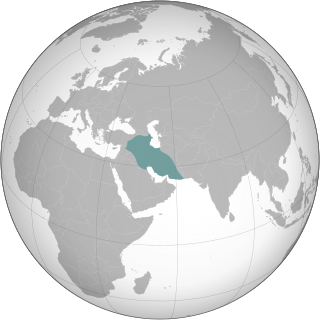
Like the Qara Qoyunlu, the Aq Qoyunlu were a semi-nomadic Turkoman confederation that rose to power after the Ilkhanate's collapse. The Aq Qoyunlu was a more long-lived and better recorded group.[224] In the 1450s and 1460s, the Aq Qoyunlu under Uzun Hasan defeated both the Qara Qoyunlu and Timurid forces and by 1469, Uzun Hasan ruled all of Iraq and Iran.[229]
Like the preceding Qara Qoyunlu, the Aq Qoyunlu rulers titled themselves as pādishāh-i Īrān (lit. 'emperor of Iran') and kesra-yi Īrān (lit. 'Caesar of Iran'), among other titles.[225] Amida was the original Aq Qoyunlu capital.[230] The capital was transferred to Tabriz under Uzun Hasan.[229]
This list only includes the Aq Qoyunlu rulers who ruled Iran.[227] For a full list, see the list of rulers of Aq Qoyunlu.
Minor kingdoms and dynasties
- Various local Iranian dynasties in Tabaristan:
- Qarinvand dynasty (550s–11th century)
- Dabuyid dynasty (642–760)
- Bavand dynasty (651–1349)
- Baduspanid dynasty (665–1598)
- Afrasiyab dynasty (1349–1504)
- Ghurid dynasty (786–1215), which controlled parts of eastern Iran
- Minor dynasties of the Iranian Intermezzo:
- Sajid dynasty (889–929) in north-western Iran and Azerbaijan
- Rawadid dynasty (900–1070/1116) in Azerbaijan
- Sallarid dynasty (919–1062) in north-western Iran and Azerbaijan
- The Ilyasids (932–968) in Kerman
- The Shaddadids (951–1199) in Armenia
- The Hasanwayhids (959–1015) in north-western Iran and Azerbaijan
- The Marwanids (983/990–1084) in Mesopotamia
- The Annazids (990/991–late 12th century) in western Iran/eastern Iraq
- The Kakuyids (1008–1141) in central Iran
- Minor successor states of the Ilkhanate:
- Kart dynasty (1244–1381) in much of Khorasan
- The Muzaffarids (1314–1393) in central and southern Iran
- The Injuids (1335–1357) in southern Iran
- Jalayirid Sultanate (1335–1432) in Iraq and western Iran
- The Sarbadars (1337–1381) in parts of Khorasan
- The Chobanids (1338–1357) in north-western Iran and Azerbaijan
Remove ads
Modern Iran (1501–1979)
Summarize
Perspective
Safavid Iran (1501–1722)
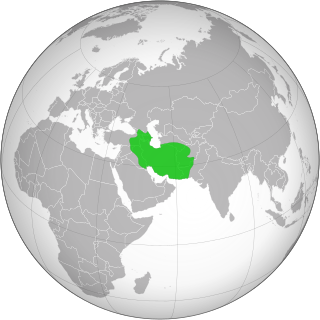
Of native Iranian (possibly Kurdish) origins,[232] the Safavid dynasty originated as the leaders of the medieval mystic Safavid order. In 1499, the Safavid sheikh Ismail defeated the Shirvanshahs of Azerbaijan and began to wrest control of Iran from the Aq Qoyunlu. The power of the Aq Qoyunlu was decisively broken in 1501 with the defeat of Alvand Beg.[233] In 1502, Ismail crowned himself šâhanšâh at Tabriz.[234] The rise of the Safavids is often considered the beginning of modern Iranian history, with their state being the earliest stage of the modern Iranian nation state.[233][235] Through further conquests, the Safavids restored Iran as a single Iranian political unit and retransformed the tribal nomadic order of the land, established during its period under Turko-Mongol rule, into a sedentary society. Shia Islam was for the first time established as the state religion.[233]
The Safavids ruled as šâhanšâh-e Irân (lit. 'King of Kings of Iran').[236] The initial capital of the Safavid Empire was at Tabriz. Due to conflict with the Ottoman Empire in the west, the capital was moved eastwards to Qazvin in 1548, and then to Isfahan in the 1590s.[233]
Intermediate period (1722–1796)
Complex rivalries in the region of Khorasan led to the Afghan Hotak dynasty invading Iran. In 1722, this conflict led to the collapse of the Safavid Empire after the siege of Isfahan.[233][238] The brief interlude between 1722 and the rise of the Qajar dynasty in 1789–1796 was marked by widespread political turmoil in Iran and several rival attempts to establish power over the country. The Safavids failed to regain power and the Hotaks failed to establish control. The rival Afsharid and Zand dynasties were established by Nader Shah (1736–1747) and Karim Khan (1751–1779), respectively. Although both of these founding figures established their rule over large parts of the former Safavid domain, the political influence of their dynasties swiftly collapsed under their successors.[238]
Hotaks (1722–1729)

In 1701, unrest among the Ghilji Pashtun tribe of Afghanistan led to a rebellion against the Safavids. This uprising was suppressed by the local commander, George XI of Kartli, but the Afghan anti-Safavid movement continued under Mirwais Hotak and his son, Mahmud Hotak. Mahmud initially feigned loyalty and was officially appointed as governor of Kandahar. In 1720, he began raiding the Kerman area and in March 1722, a larger hastily assembled and more powerful Safavid army was defeated at the Battle of Gulnabad. Following a six-month siege of Isfahan, Soltan Hoseyn I formally submitted to Mahmud and recognized him as the new shah of Iran.[233] The Hotak rulers of Iran ruled from the former Safavid capital of Isfahan.[239]
Safavid dynasts (1722–1773)
When news of the fall of Isfahan reached Soltan Hoseyn I's son Tahmasp II at Qazvin, Tahmasp proclaimed himself shah.[233] Pro-Safavid forces successfully defeated Ashraf Hotak in 1729 and forced to Afghan forces out of Iran.[239] Tahmasp failed to assert his authority in the aftermath of the Hotak invasion and the effective ruler of Iran was instead the general Nader Khan. In 1732, Nader deposed Tahmasp and replaced him with the eight-month old Abbas III. Abbas was in turn deposed in 1736 and Nader Khan was proclaimed the new shah of Iran under the name Nader Shah, terminating the Safavid dynasty.[240] Safavid descendants continued to emerge for some time after 1736 as pretenders or as figurehead rulers put forward by warlords vying for power in Iran.[241]
Afsharids (1736–1796)

The Afsharid dynasty was established by Nader Shah, a general under the Safavids who seized control of the empire in 1736 after the deposition of Abbas III.[240] Nader was a powerful conqueror but the Afsharid Empire quickly collapsed after his assassination in 1747. Large territories fell to the rival Zand dynasty as well as the Afghan Durrani Empire. The domain of Nader's heirs became largely confined to the Iranian parts of Khorasan. For most of its later history, the Afsharid state was dominated by military leaders or other court factions.[242] The Afsharids ruled with the style of šâhanšâh[245] and their capital was at Mashhad.[242]
Zands (1751–1794)

In the aftermath of Nader Shah's assassination, the Zand family grew to become the most powerful rivals of the Afsharids and seized control of much of Iran in the 1750s.[246] Established by the tribal leader Karim Khan Zand, the Zand rulers never proclaimed themselves to be shahs.[246][247] Instead, they presented themselves as regents of Iran, at first on behalf of the Safavid puppet Ismail III (1750–1773) and then on behalf of the Iranian people.[246][247] Karim Khan Zand ruled with the title of khân, as well as the style of wakil (regent) or wakil-al-raʿāyāʾ (lit. 'regent of the people').[247] His successors ruled simply as khân, though were often considered to be "kings" by European observers.[247] The Zand dynasty ruled from Shiraz.[247]
Qajar Iran (1789–1925)

The Qajar dynasty originated as a local Turkoman[251] noble family in northern Iran, under the Safavids.[246] The Qajars gradually increased in power as other families fought each other in Iran, culminating in Agha Mohammad Shah proclaiming himself ruler in 1789, in opposition to the Afsharids and Zands.[251] Agha Mohammad defeated the Zand dynasty in 1794[246] and was officially crowned in 1796.[251] Shortly thereafter, he captured and deposed the Afsharid Shahrokh Shah, reunifying Iran under a single ruler.[251]
Agha Mohammad Shah ruled with the title khân and later šâh, never assuming the more grandiose šâhanšâh.[252] Agha Mohammad's successor, Fath-Ali Shah, assumed both šâhanšâh and the Mongol khagan,[252] titles frequently used by later Qajar rulers.[253] Many other honorifics of imperial and religious significance were also used by the Qajar rulers.[252] The Qajar dynasty ruled from Tehran, inaugurated as Iran's capital in the 1780s under Agha Mohammad Shah.[254]
Pahlavi Iran (1925–1979)

During the late Qajar dynasty, Iran became increasingly embroiled in internal political turmoil over the extent of the monarch's power, among other events leading to the Persian Constitutional Revolution (1905–1911). In 1923, the brigade commander Reza Khan quickly rose through the ranks to become prime minister.[263] In 1925, Reza succeeded in deposing Ahmad Shah and having himself proclaimed by Iran's National Assembly first as regent and then as the new monarch.[264] As his family name, Reza took Pahlavi, after the Pahlavi language of the pre-Islamic Sasanian Empire.[264]
The Pahlavi rulers styled themselves as šâhanšâh-e Irân (lit. 'King of Kings of Iran').[264][265] Tehran remained the capital of Iran under Pahlavi rule.[266]
Remove ads
See also
- History of Iran – a general overview of Iranian history
- Monarchism in Iran – advocacy for restoring the Iranian monarchy
- List of royal consorts of Iran – the consorts of the rulers of Iran
- Pishdadian dynasty and Kayanian dynasty – two legendary Iranian dynasties from the Avesta and the Shahnameh
- List of rulers of the pre-Achaemenid kingdoms of Iran – poorly attested regional rulers before the Achaemenid Empire
Remove ads
Notes
- First monarch of the Media-based Median kingdom.
- First monarch of the Persis-based Achaemenid Empire.
- With regard to the name of Iran: "Persia" was an exonym used by the ancient Greeks to refer to the Achaemenid Empire, derived from the Persians (the Iranian ethnic group to which the Achaemenid dynasty belonged). Consequently, "Persia" was the word commonly used in the Western world to refer to Iran and its people, regardless of their ethnicity. "Iran" (Persian: ایران) is the country's endonym, first attested under the Sasanian Empire, though earlier forms of the name (see Aryan and Arya) date back to the Proto-Indo-Iranian people[1][2][3] and had been used ever since. In 1935, the Iranian king Reza Shah requested that foreign delegates begin using "Iran" rather than "Persia" in formal correspondence, whereafter "Iran" has also become the common name used in the Western world and internationally.
- In Babylonia, the standard title up until the reign of Xerxes I was 'King of Babylon, King of the Lands'.[21] In more elaborate contexts, the royal style could be augmented with additional titles, such as "the Great King" and "King in Persia".[22] The Achaemenid king was referred to as "the Great King" by the Greeks and as the "Lord of Kings" by the Phoenicians.[21]
- Enumerated as Alexander III as king of Macedon (after Alexander I and Alexander II).
- The date of Alexander's victory at the Battle of Gaugamela, which opened the way for his conquest of Babylonia and Persia.[43]
- Enumerated as Alexander IV as king of Macedon (after Alexander I, Alexander II, and Alexander the Great).
- The Parthian conquest of Babylonia, whereafter Mithridates I assumed the style 'Great King' and firmly established his empire.
- Often enumerated as Tiridates II, after Tiridates I, a supposed Parthian king now believed to be unhistorical.[68]
- The other three were Boran (630), Azarmidokht (630–631), and Sati Beg (1338/1339–1339/1340).
- Sometimes enumerated as Artabanus IV or Artabanus V (see note on Artabanus II).
- Sometimes enumerated as Mithridates V (see note on Mithridates III).
- Sometimes enumerated as Vologases IV (see note on Vologases II).
- Sometimes enumerated as Vologases V (see note on Vologases II).
- Sometimes enumerated as Vologases VI (see note on Vologases II).
- Sometimes enumerated as Artabanus V or Artabanus VI (see note on Artabanus II).
- Khosrow's rule was brief and ephemeral and he is not counted in the numbering of later kings of this name.
- The other three were Musa (2 BC–AD 4), Azarmidokht (630–631), and Sati Beg (1338/1339–1339/1340).
- Rukn al-Dawla claimed Iranian imperial status by 962, when he minted a medal depicting him similar to a Sasanian ruler with the inscription "may the glory of the king of kings increase".[158] 'Adud al-Dawla also claimed the title šāhānšāh by 965. In 969, he minted a medal with the inscriptions "šāhānšāh, may his glory increase" and "May šāh Panāh Khusraw live long".[161] The caliphs opposed Buyid use of the old imperial title.[161] 'Adud al-Dawla's son Baha al-Dawla is recorded to have used the Arabic version of 'King of Kings' (malik al-mulūk) and the title is also recorded in both Arabic and Persian for Baha al-Dawla's grandson Abu Kalijar Marzuban.[162] The title was sometimes assumed by rival emirs not part of the 'main branch' listed below, such as Fakhr al-Dawla and Musharrif al-Dawla.
- The other three were Musa (2 BC–AD 4), Boran (630), and Azarmidokht (630–631).
Remove ads
References
Wikiwand - on
Seamless Wikipedia browsing. On steroids.
Remove ads

